Azzaz Report: Operations and Information Management, Azzaz Case Study
VerifiedAdded on 2019/09/25
|9
|2315
|452
Report
AI Summary
This document is a comprehensive report analyzing the Azzaz case study, a mobile phone and accessories retailer. The assignment, worth 50% of the module mark, includes four parts: Part A involves developing business process models and strategic analysis using techniques like SWOT or PESTLE. Part B requires a comparison of open-source software solutions. Part C is a detailed report providing an overview of Azzaz's current situation and a roadmap for proposed business changes, including software recommendations and implementation strategies. Part D is a reflective summary of the student's contributions to online discussions and the wiki, using a reflection self-assessment proforma to evaluate their engagement and understanding of the module's concepts. The report aims to integrate IT systems, including b2c eCommerce functionality, with retail stores, allowing for customer collection and returns via stores and courier services. The student is expected to make assumptions where information is incomplete and support recommendations with module theories and frameworks.
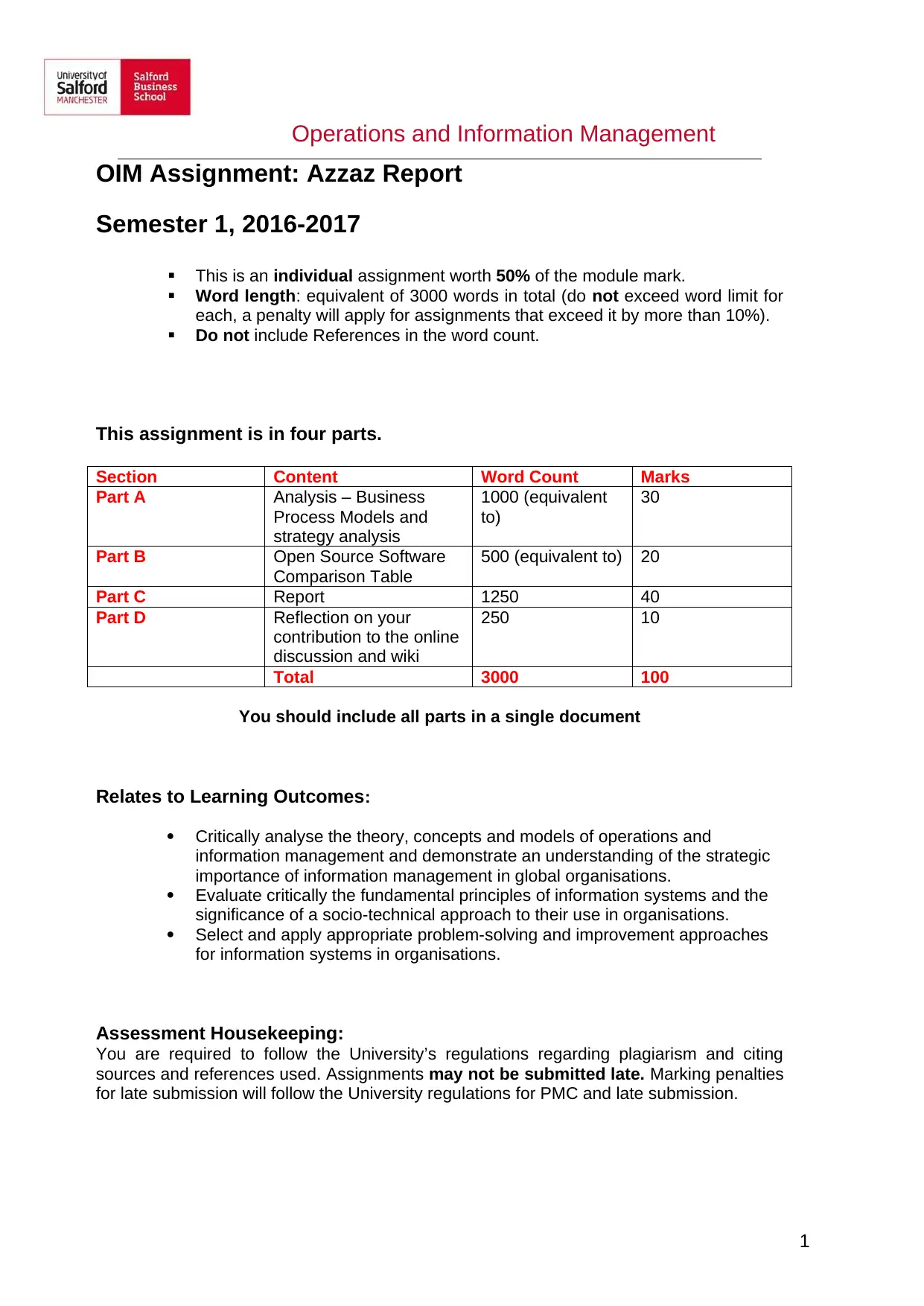
OIM Assignment: Azzaz Report
Semester 1, 2016-2017
This is an individual assignment worth 50% of the module mark.
Word length: equivalent of 3000 words in total (do not exceed word limit for
each, a penalty will apply for assignments that exceed it by more than 10%).
Do not include References in the word count.
This assignment is in four parts.
Section Content Word Count Marks
Part A Analysis – Business
Process Models and
strategy analysis
1000 (equivalent
to)
30
Part B Open Source Software
Comparison Table
500 (equivalent to) 20
Part C Report 1250 40
Part D Reflection on your
contribution to the online
discussion and wiki
250 10
Total 3000 100
You should include all parts in a single document
Relates to Learning Outcomes:
Critically analyse the theory, concepts and models of operations and
information management and demonstrate an understanding of the strategic
importance of information management in global organisations.
Evaluate critically the fundamental principles of information systems and the
significance of a socio-technical approach to their use in organisations.
Select and apply appropriate problem-solving and improvement approaches
for information systems in organisations.
Assessment Housekeeping:
You are required to follow the University’s regulations regarding plagiarism and citing
sources and references used. Assignments may not be submitted late. Marking penalties
for late submission will follow the University regulations for PMC and late submission.
1
Operations and Information Management
Semester 1, 2016-2017
This is an individual assignment worth 50% of the module mark.
Word length: equivalent of 3000 words in total (do not exceed word limit for
each, a penalty will apply for assignments that exceed it by more than 10%).
Do not include References in the word count.
This assignment is in four parts.
Section Content Word Count Marks
Part A Analysis – Business
Process Models and
strategy analysis
1000 (equivalent
to)
30
Part B Open Source Software
Comparison Table
500 (equivalent to) 20
Part C Report 1250 40
Part D Reflection on your
contribution to the online
discussion and wiki
250 10
Total 3000 100
You should include all parts in a single document
Relates to Learning Outcomes:
Critically analyse the theory, concepts and models of operations and
information management and demonstrate an understanding of the strategic
importance of information management in global organisations.
Evaluate critically the fundamental principles of information systems and the
significance of a socio-technical approach to their use in organisations.
Select and apply appropriate problem-solving and improvement approaches
for information systems in organisations.
Assessment Housekeeping:
You are required to follow the University’s regulations regarding plagiarism and citing
sources and references used. Assignments may not be submitted late. Marking penalties
for late submission will follow the University regulations for PMC and late submission.
1
Operations and Information Management
Paraphrase This Document
Need a fresh take? Get an instant paraphrase of this document with our AI Paraphraser
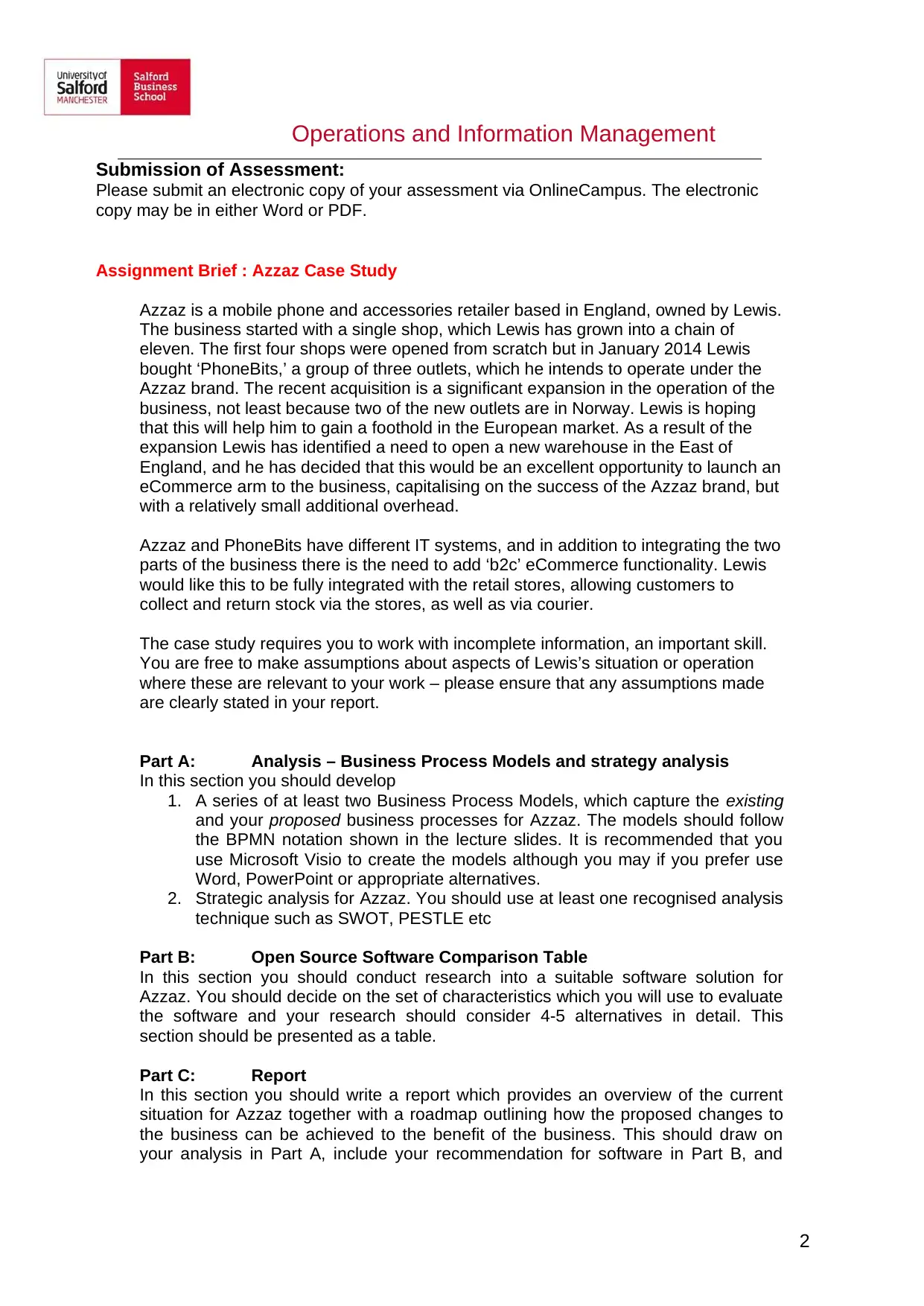
Submission of Assessment:
Please submit an electronic copy of your assessment via OnlineCampus. The electronic
copy may be in either Word or PDF.
Assignment Brief : Azzaz Case Study
Azzaz is a mobile phone and accessories retailer based in England, owned by Lewis.
The business started with a single shop, which Lewis has grown into a chain of
eleven. The first four shops were opened from scratch but in January 2014 Lewis
bought ‘PhoneBits,’ a group of three outlets, which he intends to operate under the
Azzaz brand. The recent acquisition is a significant expansion in the operation of the
business, not least because two of the new outlets are in Norway. Lewis is hoping
that this will help him to gain a foothold in the European market. As a result of the
expansion Lewis has identified a need to open a new warehouse in the East of
England, and he has decided that this would be an excellent opportunity to launch an
eCommerce arm to the business, capitalising on the success of the Azzaz brand, but
with a relatively small additional overhead.
Azzaz and PhoneBits have different IT systems, and in addition to integrating the two
parts of the business there is the need to add ‘b2c’ eCommerce functionality. Lewis
would like this to be fully integrated with the retail stores, allowing customers to
collect and return stock via the stores, as well as via courier.
The case study requires you to work with incomplete information, an important skill.
You are free to make assumptions about aspects of Lewis’s situation or operation
where these are relevant to your work – please ensure that any assumptions made
are clearly stated in your report.
Part A: Analysis – Business Process Models and strategy analysis
In this section you should develop
1. A series of at least two Business Process Models, which capture the existing
and your proposed business processes for Azzaz. The models should follow
the BPMN notation shown in the lecture slides. It is recommended that you
use Microsoft Visio to create the models although you may if you prefer use
Word, PowerPoint or appropriate alternatives.
2. Strategic analysis for Azzaz. You should use at least one recognised analysis
technique such as SWOT, PESTLE etc
Part B: Open Source Software Comparison Table
In this section you should conduct research into a suitable software solution for
Azzaz. You should decide on the set of characteristics which you will use to evaluate
the software and your research should consider 4-5 alternatives in detail. This
section should be presented as a table.
Part C: Report
In this section you should write a report which provides an overview of the current
situation for Azzaz together with a roadmap outlining how the proposed changes to
the business can be achieved to the benefit of the business. This should draw on
your analysis in Part A, include your recommendation for software in Part B, and
2
Operations and Information Management
Please submit an electronic copy of your assessment via OnlineCampus. The electronic
copy may be in either Word or PDF.
Assignment Brief : Azzaz Case Study
Azzaz is a mobile phone and accessories retailer based in England, owned by Lewis.
The business started with a single shop, which Lewis has grown into a chain of
eleven. The first four shops were opened from scratch but in January 2014 Lewis
bought ‘PhoneBits,’ a group of three outlets, which he intends to operate under the
Azzaz brand. The recent acquisition is a significant expansion in the operation of the
business, not least because two of the new outlets are in Norway. Lewis is hoping
that this will help him to gain a foothold in the European market. As a result of the
expansion Lewis has identified a need to open a new warehouse in the East of
England, and he has decided that this would be an excellent opportunity to launch an
eCommerce arm to the business, capitalising on the success of the Azzaz brand, but
with a relatively small additional overhead.
Azzaz and PhoneBits have different IT systems, and in addition to integrating the two
parts of the business there is the need to add ‘b2c’ eCommerce functionality. Lewis
would like this to be fully integrated with the retail stores, allowing customers to
collect and return stock via the stores, as well as via courier.
The case study requires you to work with incomplete information, an important skill.
You are free to make assumptions about aspects of Lewis’s situation or operation
where these are relevant to your work – please ensure that any assumptions made
are clearly stated in your report.
Part A: Analysis – Business Process Models and strategy analysis
In this section you should develop
1. A series of at least two Business Process Models, which capture the existing
and your proposed business processes for Azzaz. The models should follow
the BPMN notation shown in the lecture slides. It is recommended that you
use Microsoft Visio to create the models although you may if you prefer use
Word, PowerPoint or appropriate alternatives.
2. Strategic analysis for Azzaz. You should use at least one recognised analysis
technique such as SWOT, PESTLE etc
Part B: Open Source Software Comparison Table
In this section you should conduct research into a suitable software solution for
Azzaz. You should decide on the set of characteristics which you will use to evaluate
the software and your research should consider 4-5 alternatives in detail. This
section should be presented as a table.
Part C: Report
In this section you should write a report which provides an overview of the current
situation for Azzaz together with a roadmap outlining how the proposed changes to
the business can be achieved to the benefit of the business. This should draw on
your analysis in Part A, include your recommendation for software in Part B, and
2
Operations and Information Management
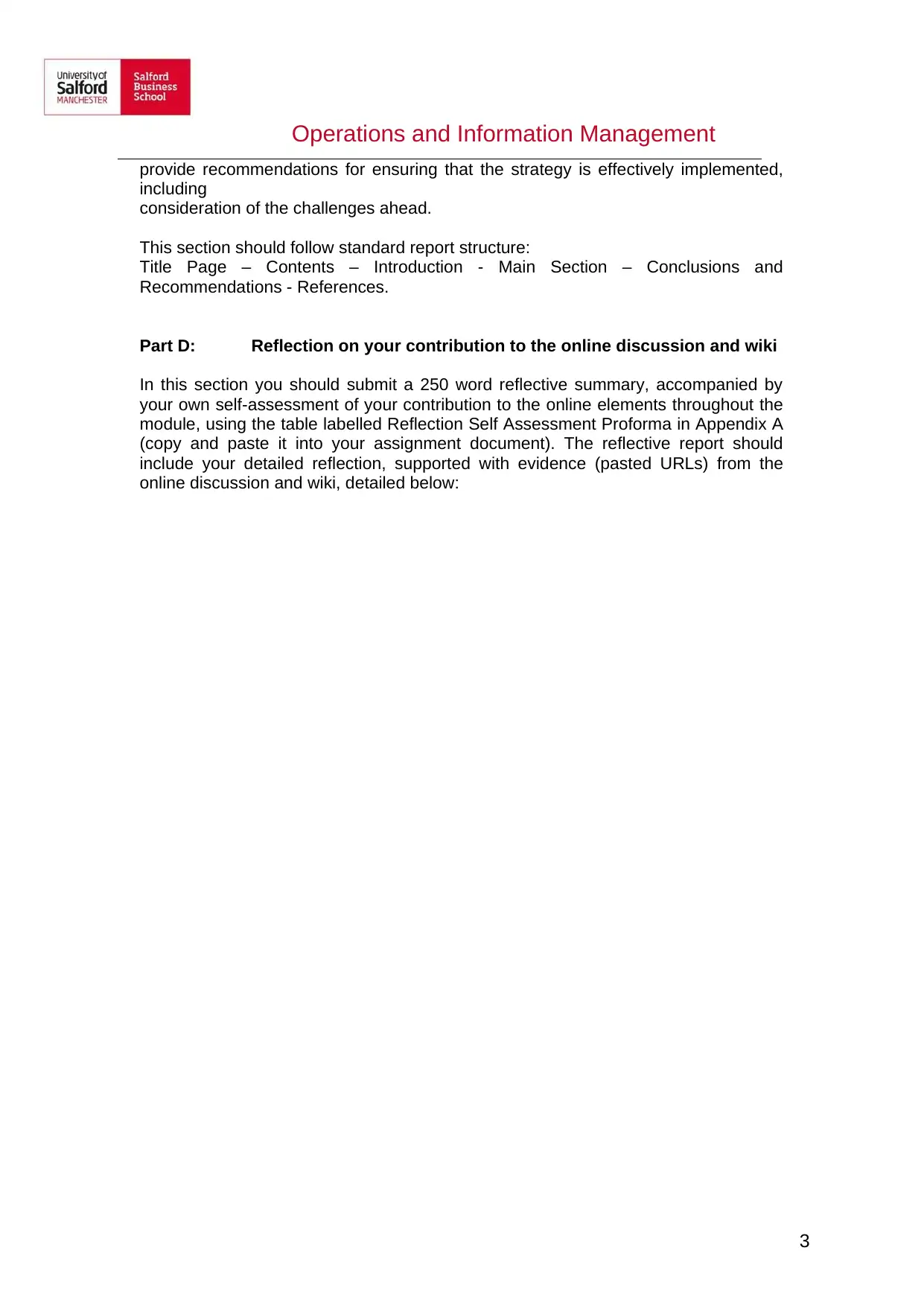
provide recommendations for ensuring that the strategy is effectively implemented,
including
consideration of the challenges ahead.
This section should follow standard report structure:
Title Page – Contents – Introduction - Main Section – Conclusions and
Recommendations - References.
Part D: Reflection on your contribution to the online discussion and wiki
In this section you should submit a 250 word reflective summary, accompanied by
your own self-assessment of your contribution to the online elements throughout the
module, using the table labelled Reflection Self Assessment Proforma in Appendix A
(copy and paste it into your assignment document). The reflective report should
include your detailed reflection, supported with evidence (pasted URLs) from the
online discussion and wiki, detailed below:
3
Operations and Information Management
including
consideration of the challenges ahead.
This section should follow standard report structure:
Title Page – Contents – Introduction - Main Section – Conclusions and
Recommendations - References.
Part D: Reflection on your contribution to the online discussion and wiki
In this section you should submit a 250 word reflective summary, accompanied by
your own self-assessment of your contribution to the online elements throughout the
module, using the table labelled Reflection Self Assessment Proforma in Appendix A
(copy and paste it into your assignment document). The reflective report should
include your detailed reflection, supported with evidence (pasted URLs) from the
online discussion and wiki, detailed below:
3
Operations and Information Management
⊘ This is a preview!⊘
Do you want full access?
Subscribe today to unlock all pages.

Trusted by 1+ million students worldwide
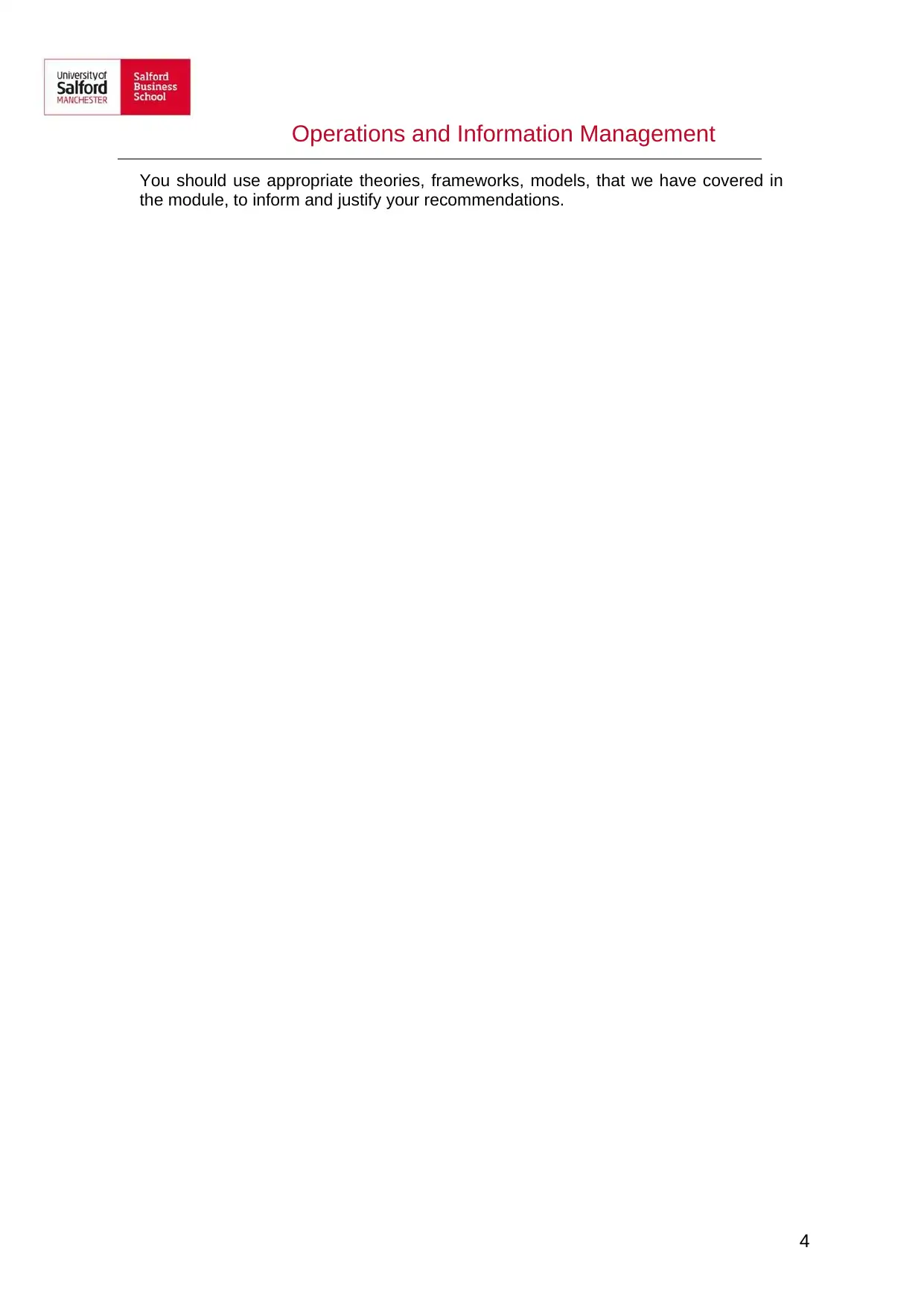
You should use appropriate theories, frameworks, models, that we have covered in
the module, to inform and justify your recommendations.
4
Operations and Information Management
the module, to inform and justify your recommendations.
4
Operations and Information Management
Paraphrase This Document
Need a fresh take? Get an instant paraphrase of this document with our AI Paraphraser
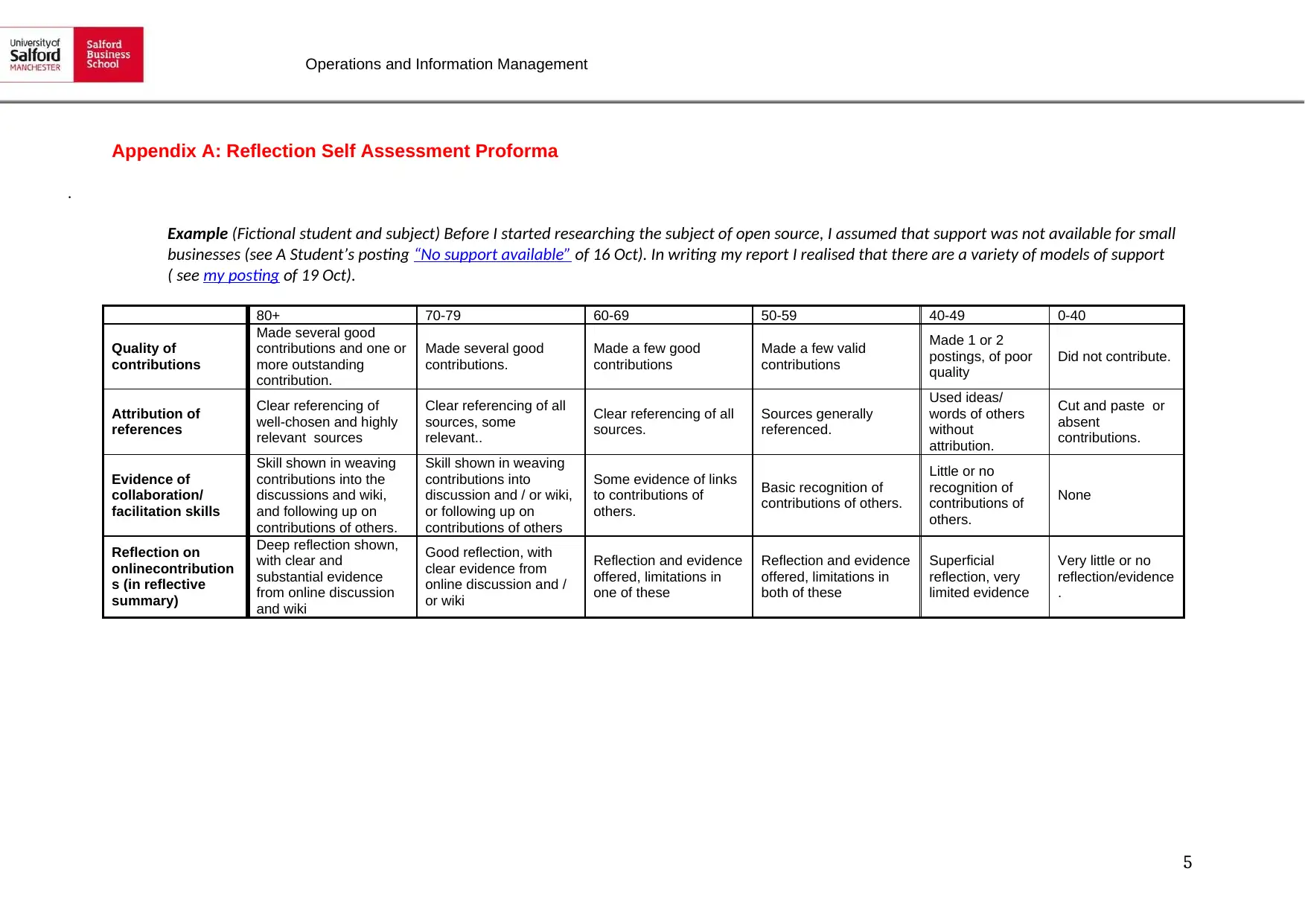
Operations and Information Management
Appendix A: Reflection Self Assessment Proforma
.
Example (Fictional student and subject) Before I started researching the subject of open source, I assumed that support was not available for small
businesses (see A Student’s posting “No support available” of 16 Oct). In writing my report I realised that there are a variety of models of support
( see my posting of 19 Oct).
80+ 70-79 60-69 50-59 40-49 0-40
Quality of
contributions
Made several good
contributions and one or
more outstanding
contribution.
Made several good
contributions.
Made a few good
contributions
Made a few valid
contributions
Made 1 or 2
postings, of poor
quality
Did not contribute.
Attribution of
references
Clear referencing of
well-chosen and highly
relevant sources
Clear referencing of all
sources, some
relevant..
Clear referencing of all
sources.
Sources generally
referenced.
Used ideas/
words of others
without
attribution.
Cut and paste or
absent
contributions.
Evidence of
collaboration/
facilitation skills
Skill shown in weaving
contributions into the
discussions and wiki,
and following up on
contributions of others.
Skill shown in weaving
contributions into
discussion and / or wiki,
or following up on
contributions of others
Some evidence of links
to contributions of
others.
Basic recognition of
contributions of others.
Little or no
recognition of
contributions of
others.
None
Reflection on
onlinecontribution
s (in reflective
summary)
Deep reflection shown,
with clear and
substantial evidence
from online discussion
and wiki
Good reflection, with
clear evidence from
online discussion and /
or wiki
Reflection and evidence
offered, limitations in
one of these
Reflection and evidence
offered, limitations in
both of these
Superficial
reflection, very
limited evidence
Very little or no
reflection/evidence
.
5
Appendix A: Reflection Self Assessment Proforma
.
Example (Fictional student and subject) Before I started researching the subject of open source, I assumed that support was not available for small
businesses (see A Student’s posting “No support available” of 16 Oct). In writing my report I realised that there are a variety of models of support
( see my posting of 19 Oct).
80+ 70-79 60-69 50-59 40-49 0-40
Quality of
contributions
Made several good
contributions and one or
more outstanding
contribution.
Made several good
contributions.
Made a few good
contributions
Made a few valid
contributions
Made 1 or 2
postings, of poor
quality
Did not contribute.
Attribution of
references
Clear referencing of
well-chosen and highly
relevant sources
Clear referencing of all
sources, some
relevant..
Clear referencing of all
sources.
Sources generally
referenced.
Used ideas/
words of others
without
attribution.
Cut and paste or
absent
contributions.
Evidence of
collaboration/
facilitation skills
Skill shown in weaving
contributions into the
discussions and wiki,
and following up on
contributions of others.
Skill shown in weaving
contributions into
discussion and / or wiki,
or following up on
contributions of others
Some evidence of links
to contributions of
others.
Basic recognition of
contributions of others.
Little or no
recognition of
contributions of
others.
None
Reflection on
onlinecontribution
s (in reflective
summary)
Deep reflection shown,
with clear and
substantial evidence
from online discussion
and wiki
Good reflection, with
clear evidence from
online discussion and /
or wiki
Reflection and evidence
offered, limitations in
one of these
Reflection and evidence
offered, limitations in
both of these
Superficial
reflection, very
limited evidence
Very little or no
reflection/evidence
.
5
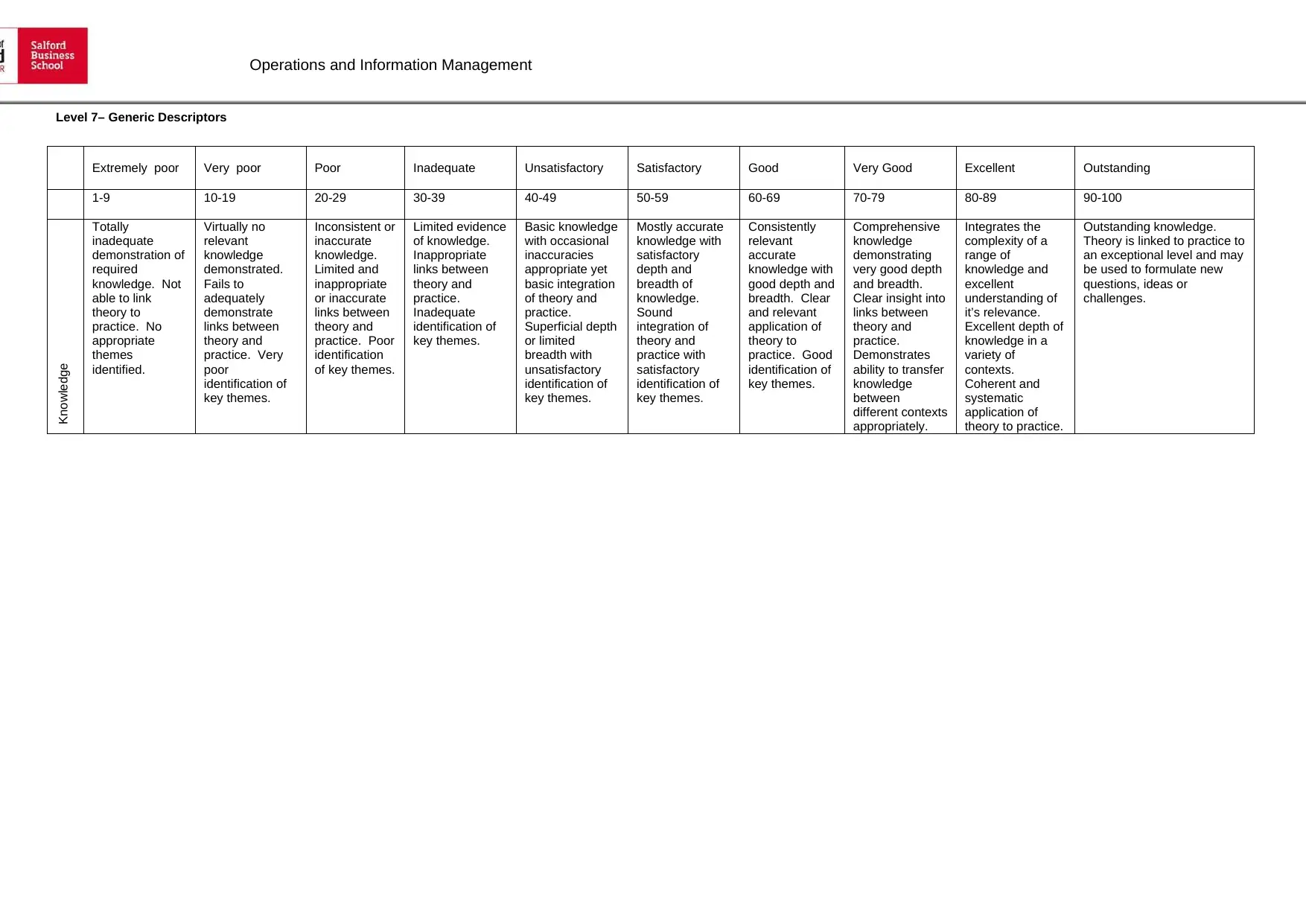
Operations and Information Management
Level 7– Generic Descriptors
Extremely poor Very poor Poor Inadequate Unsatisfactory Satisfactory Good Very Good Excellent Outstanding
1-9 10-19 20-29 30-39 40-49 50-59 60-69 70-79 80-89 90-100
Knowledge
Totally
inadequate
demonstration of
required
knowledge. Not
able to link
theory to
practice. No
appropriate
themes
identified.
Virtually no
relevant
knowledge
demonstrated.
Fails to
adequately
demonstrate
links between
theory and
practice. Very
poor
identification of
key themes.
Inconsistent or
inaccurate
knowledge.
Limited and
inappropriate
or inaccurate
links between
theory and
practice. Poor
identification
of key themes.
Limited evidence
of knowledge.
Inappropriate
links between
theory and
practice.
Inadequate
identification of
key themes.
Basic knowledge
with occasional
inaccuracies
appropriate yet
basic integration
of theory and
practice.
Superficial depth
or limited
breadth with
unsatisfactory
identification of
key themes.
Mostly accurate
knowledge with
satisfactory
depth and
breadth of
knowledge.
Sound
integration of
theory and
practice with
satisfactory
identification of
key themes.
Consistently
relevant
accurate
knowledge with
good depth and
breadth. Clear
and relevant
application of
theory to
practice. Good
identification of
key themes.
Comprehensive
knowledge
demonstrating
very good depth
and breadth.
Clear insight into
links between
theory and
practice.
Demonstrates
ability to transfer
knowledge
between
different contexts
appropriately.
Integrates the
complexity of a
range of
knowledge and
excellent
understanding of
it’s relevance.
Excellent depth of
knowledge in a
variety of
contexts.
Coherent and
systematic
application of
theory to practice.
Outstanding knowledge.
Theory is linked to practice to
an exceptional level and may
be used to formulate new
questions, ideas or
challenges.
Level 7– Generic Descriptors
Extremely poor Very poor Poor Inadequate Unsatisfactory Satisfactory Good Very Good Excellent Outstanding
1-9 10-19 20-29 30-39 40-49 50-59 60-69 70-79 80-89 90-100
Knowledge
Totally
inadequate
demonstration of
required
knowledge. Not
able to link
theory to
practice. No
appropriate
themes
identified.
Virtually no
relevant
knowledge
demonstrated.
Fails to
adequately
demonstrate
links between
theory and
practice. Very
poor
identification of
key themes.
Inconsistent or
inaccurate
knowledge.
Limited and
inappropriate
or inaccurate
links between
theory and
practice. Poor
identification
of key themes.
Limited evidence
of knowledge.
Inappropriate
links between
theory and
practice.
Inadequate
identification of
key themes.
Basic knowledge
with occasional
inaccuracies
appropriate yet
basic integration
of theory and
practice.
Superficial depth
or limited
breadth with
unsatisfactory
identification of
key themes.
Mostly accurate
knowledge with
satisfactory
depth and
breadth of
knowledge.
Sound
integration of
theory and
practice with
satisfactory
identification of
key themes.
Consistently
relevant
accurate
knowledge with
good depth and
breadth. Clear
and relevant
application of
theory to
practice. Good
identification of
key themes.
Comprehensive
knowledge
demonstrating
very good depth
and breadth.
Clear insight into
links between
theory and
practice.
Demonstrates
ability to transfer
knowledge
between
different contexts
appropriately.
Integrates the
complexity of a
range of
knowledge and
excellent
understanding of
it’s relevance.
Excellent depth of
knowledge in a
variety of
contexts.
Coherent and
systematic
application of
theory to practice.
Outstanding knowledge.
Theory is linked to practice to
an exceptional level and may
be used to formulate new
questions, ideas or
challenges.
⊘ This is a preview!⊘
Do you want full access?
Subscribe today to unlock all pages.

Trusted by 1+ million students worldwide
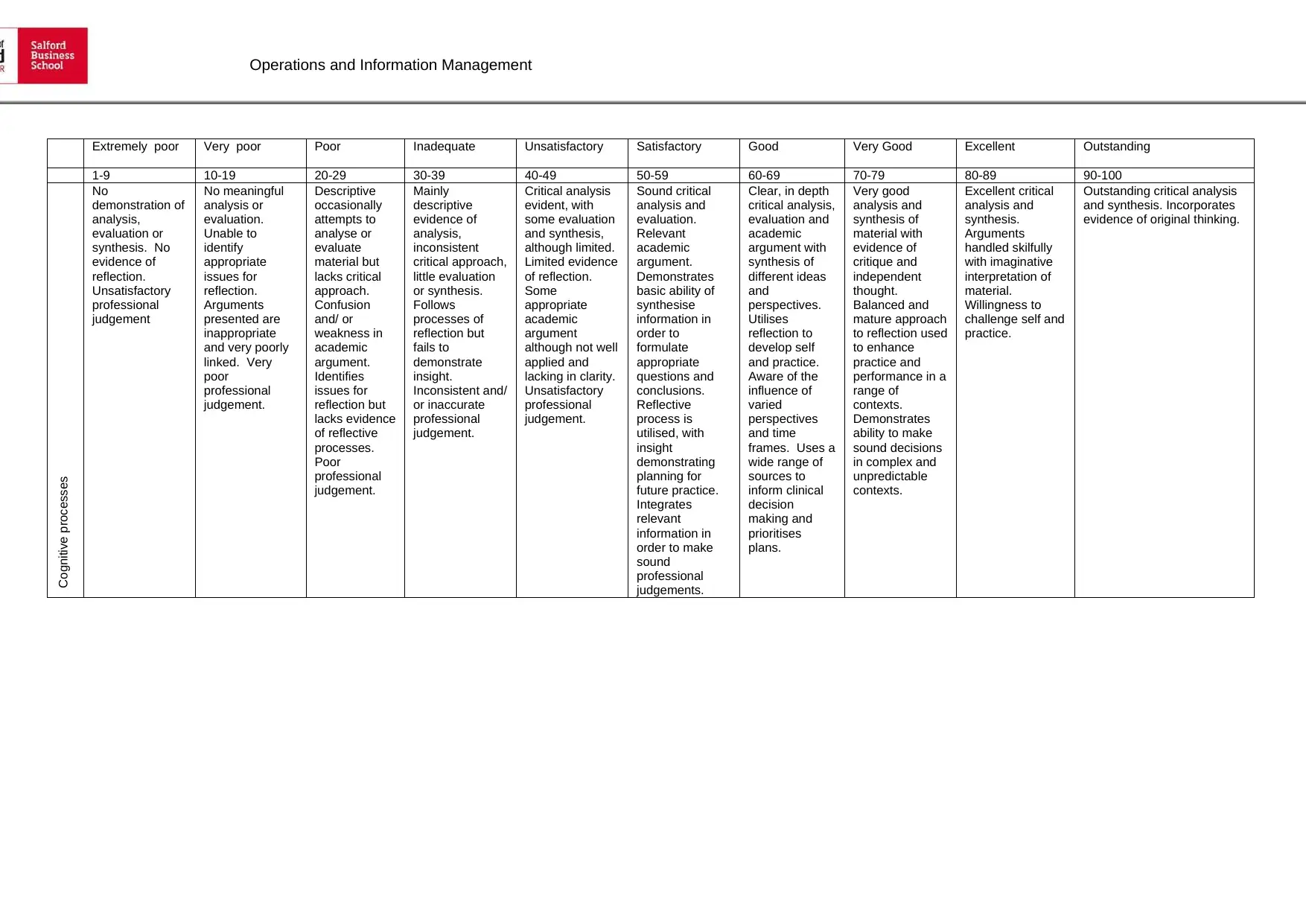
Operations and Information Management
Extremely poor Very poor Poor Inadequate Unsatisfactory Satisfactory Good Very Good Excellent Outstanding
1-9 10-19 20-29 30-39 40-49 50-59 60-69 70-79 80-89 90-100
Cognitive processes
No
demonstration of
analysis,
evaluation or
synthesis. No
evidence of
reflection.
Unsatisfactory
professional
judgement
No meaningful
analysis or
evaluation.
Unable to
identify
appropriate
issues for
reflection.
Arguments
presented are
inappropriate
and very poorly
linked. Very
poor
professional
judgement.
Descriptive
occasionally
attempts to
analyse or
evaluate
material but
lacks critical
approach.
Confusion
and/ or
weakness in
academic
argument.
Identifies
issues for
reflection but
lacks evidence
of reflective
processes.
Poor
professional
judgement.
Mainly
descriptive
evidence of
analysis,
inconsistent
critical approach,
little evaluation
or synthesis.
Follows
processes of
reflection but
fails to
demonstrate
insight.
Inconsistent and/
or inaccurate
professional
judgement.
Critical analysis
evident, with
some evaluation
and synthesis,
although limited.
Limited evidence
of reflection.
Some
appropriate
academic
argument
although not well
applied and
lacking in clarity.
Unsatisfactory
professional
judgement.
Sound critical
analysis and
evaluation.
Relevant
academic
argument.
Demonstrates
basic ability of
synthesise
information in
order to
formulate
appropriate
questions and
conclusions.
Reflective
process is
utilised, with
insight
demonstrating
planning for
future practice.
Integrates
relevant
information in
order to make
sound
professional
judgements.
Clear, in depth
critical analysis,
evaluation and
academic
argument with
synthesis of
different ideas
and
perspectives.
Utilises
reflection to
develop self
and practice.
Aware of the
influence of
varied
perspectives
and time
frames. Uses a
wide range of
sources to
inform clinical
decision
making and
prioritises
plans.
Very good
analysis and
synthesis of
material with
evidence of
critique and
independent
thought.
Balanced and
mature approach
to reflection used
to enhance
practice and
performance in a
range of
contexts.
Demonstrates
ability to make
sound decisions
in complex and
unpredictable
contexts.
Excellent critical
analysis and
synthesis.
Arguments
handled skilfully
with imaginative
interpretation of
material.
Willingness to
challenge self and
practice.
Outstanding critical analysis
and synthesis. Incorporates
evidence of original thinking.
Extremely poor Very poor Poor Inadequate Unsatisfactory Satisfactory Good Very Good Excellent Outstanding
1-9 10-19 20-29 30-39 40-49 50-59 60-69 70-79 80-89 90-100
Cognitive processes
No
demonstration of
analysis,
evaluation or
synthesis. No
evidence of
reflection.
Unsatisfactory
professional
judgement
No meaningful
analysis or
evaluation.
Unable to
identify
appropriate
issues for
reflection.
Arguments
presented are
inappropriate
and very poorly
linked. Very
poor
professional
judgement.
Descriptive
occasionally
attempts to
analyse or
evaluate
material but
lacks critical
approach.
Confusion
and/ or
weakness in
academic
argument.
Identifies
issues for
reflection but
lacks evidence
of reflective
processes.
Poor
professional
judgement.
Mainly
descriptive
evidence of
analysis,
inconsistent
critical approach,
little evaluation
or synthesis.
Follows
processes of
reflection but
fails to
demonstrate
insight.
Inconsistent and/
or inaccurate
professional
judgement.
Critical analysis
evident, with
some evaluation
and synthesis,
although limited.
Limited evidence
of reflection.
Some
appropriate
academic
argument
although not well
applied and
lacking in clarity.
Unsatisfactory
professional
judgement.
Sound critical
analysis and
evaluation.
Relevant
academic
argument.
Demonstrates
basic ability of
synthesise
information in
order to
formulate
appropriate
questions and
conclusions.
Reflective
process is
utilised, with
insight
demonstrating
planning for
future practice.
Integrates
relevant
information in
order to make
sound
professional
judgements.
Clear, in depth
critical analysis,
evaluation and
academic
argument with
synthesis of
different ideas
and
perspectives.
Utilises
reflection to
develop self
and practice.
Aware of the
influence of
varied
perspectives
and time
frames. Uses a
wide range of
sources to
inform clinical
decision
making and
prioritises
plans.
Very good
analysis and
synthesis of
material with
evidence of
critique and
independent
thought.
Balanced and
mature approach
to reflection used
to enhance
practice and
performance in a
range of
contexts.
Demonstrates
ability to make
sound decisions
in complex and
unpredictable
contexts.
Excellent critical
analysis and
synthesis.
Arguments
handled skilfully
with imaginative
interpretation of
material.
Willingness to
challenge self and
practice.
Outstanding critical analysis
and synthesis. Incorporates
evidence of original thinking.
Paraphrase This Document
Need a fresh take? Get an instant paraphrase of this document with our AI Paraphraser
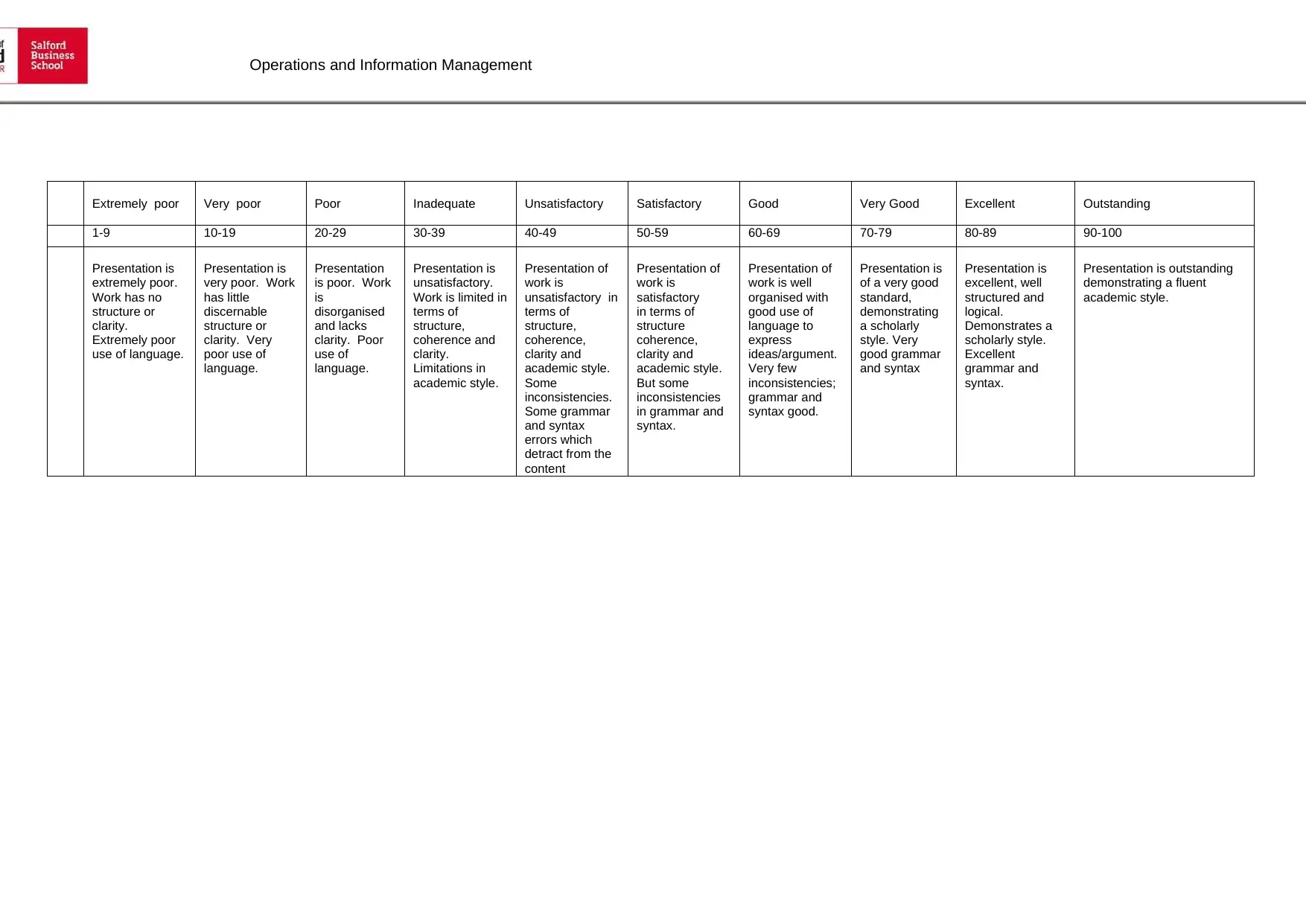
Operations and Information Management
Extremely poor Very poor Poor Inadequate Unsatisfactory Satisfactory Good Very Good Excellent Outstanding
1-9 10-19 20-29 30-39 40-49 50-59 60-69 70-79 80-89 90-100
Presentation is
extremely poor.
Work has no
structure or
clarity.
Extremely poor
use of language.
Presentation is
very poor. Work
has little
discernable
structure or
clarity. Very
poor use of
language.
Presentation
is poor. Work
is
disorganised
and lacks
clarity. Poor
use of
language.
Presentation is
unsatisfactory.
Work is limited in
terms of
structure,
coherence and
clarity.
Limitations in
academic style.
Presentation of
work is
unsatisfactory in
terms of
structure,
coherence,
clarity and
academic style.
Some
inconsistencies.
Some grammar
and syntax
errors which
detract from the
content
Presentation of
work is
satisfactory
in terms of
structure
coherence,
clarity and
academic style.
But some
inconsistencies
in grammar and
syntax.
Presentation of
work is well
organised with
good use of
language to
express
ideas/argument.
Very few
inconsistencies;
grammar and
syntax good.
Presentation is
of a very good
standard,
demonstrating
a scholarly
style. Very
good grammar
and syntax
Presentation is
excellent, well
structured and
logical.
Demonstrates a
scholarly style.
Excellent
grammar and
syntax.
Presentation is outstanding
demonstrating a fluent
academic style.
Extremely poor Very poor Poor Inadequate Unsatisfactory Satisfactory Good Very Good Excellent Outstanding
1-9 10-19 20-29 30-39 40-49 50-59 60-69 70-79 80-89 90-100
Presentation is
extremely poor.
Work has no
structure or
clarity.
Extremely poor
use of language.
Presentation is
very poor. Work
has little
discernable
structure or
clarity. Very
poor use of
language.
Presentation
is poor. Work
is
disorganised
and lacks
clarity. Poor
use of
language.
Presentation is
unsatisfactory.
Work is limited in
terms of
structure,
coherence and
clarity.
Limitations in
academic style.
Presentation of
work is
unsatisfactory in
terms of
structure,
coherence,
clarity and
academic style.
Some
inconsistencies.
Some grammar
and syntax
errors which
detract from the
content
Presentation of
work is
satisfactory
in terms of
structure
coherence,
clarity and
academic style.
But some
inconsistencies
in grammar and
syntax.
Presentation of
work is well
organised with
good use of
language to
express
ideas/argument.
Very few
inconsistencies;
grammar and
syntax good.
Presentation is
of a very good
standard,
demonstrating
a scholarly
style. Very
good grammar
and syntax
Presentation is
excellent, well
structured and
logical.
Demonstrates a
scholarly style.
Excellent
grammar and
syntax.
Presentation is outstanding
demonstrating a fluent
academic style.
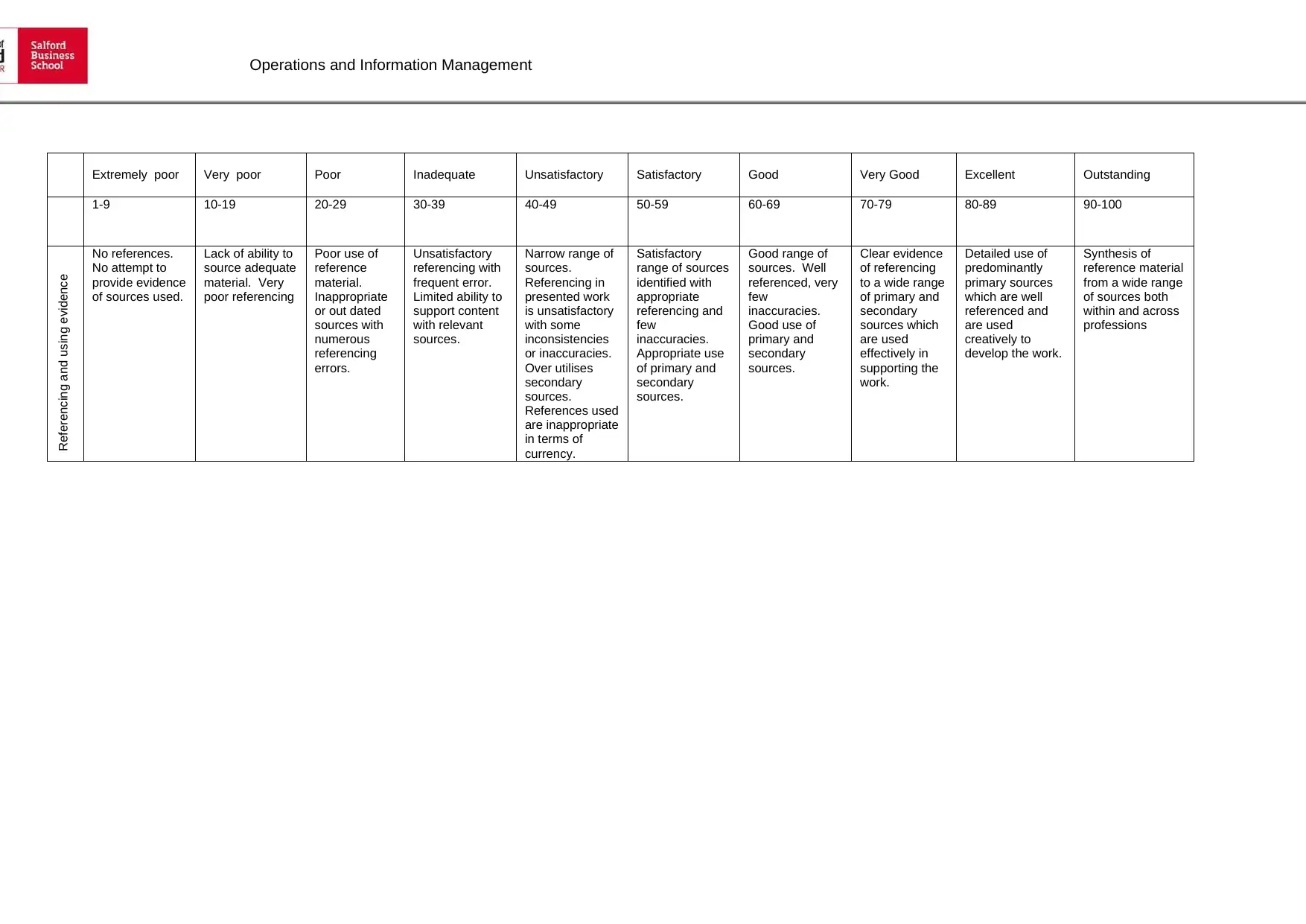
Operations and Information Management
Extremely poor Very poor Poor Inadequate Unsatisfactory Satisfactory Good Very Good Excellent Outstanding
1-9 10-19 20-29 30-39 40-49 50-59 60-69 70-79 80-89 90-100
Referencing and using evidence
No references.
No attempt to
provide evidence
of sources used.
Lack of ability to
source adequate
material. Very
poor referencing
Poor use of
reference
material.
Inappropriate
or out dated
sources with
numerous
referencing
errors.
Unsatisfactory
referencing with
frequent error.
Limited ability to
support content
with relevant
sources.
Narrow range of
sources.
Referencing in
presented work
is unsatisfactory
with some
inconsistencies
or inaccuracies.
Over utilises
secondary
sources.
References used
are inappropriate
in terms of
currency.
Satisfactory
range of sources
identified with
appropriate
referencing and
few
inaccuracies.
Appropriate use
of primary and
secondary
sources.
Good range of
sources. Well
referenced, very
few
inaccuracies.
Good use of
primary and
secondary
sources.
Clear evidence
of referencing
to a wide range
of primary and
secondary
sources which
are used
effectively in
supporting the
work.
Detailed use of
predominantly
primary sources
which are well
referenced and
are used
creatively to
develop the work.
Synthesis of
reference material
from a wide range
of sources both
within and across
professions
Extremely poor Very poor Poor Inadequate Unsatisfactory Satisfactory Good Very Good Excellent Outstanding
1-9 10-19 20-29 30-39 40-49 50-59 60-69 70-79 80-89 90-100
Referencing and using evidence
No references.
No attempt to
provide evidence
of sources used.
Lack of ability to
source adequate
material. Very
poor referencing
Poor use of
reference
material.
Inappropriate
or out dated
sources with
numerous
referencing
errors.
Unsatisfactory
referencing with
frequent error.
Limited ability to
support content
with relevant
sources.
Narrow range of
sources.
Referencing in
presented work
is unsatisfactory
with some
inconsistencies
or inaccuracies.
Over utilises
secondary
sources.
References used
are inappropriate
in terms of
currency.
Satisfactory
range of sources
identified with
appropriate
referencing and
few
inaccuracies.
Appropriate use
of primary and
secondary
sources.
Good range of
sources. Well
referenced, very
few
inaccuracies.
Good use of
primary and
secondary
sources.
Clear evidence
of referencing
to a wide range
of primary and
secondary
sources which
are used
effectively in
supporting the
work.
Detailed use of
predominantly
primary sources
which are well
referenced and
are used
creatively to
develop the work.
Synthesis of
reference material
from a wide range
of sources both
within and across
professions
⊘ This is a preview!⊘
Do you want full access?
Subscribe today to unlock all pages.

Trusted by 1+ million students worldwide
1 out of 9
Related Documents
Your All-in-One AI-Powered Toolkit for Academic Success.
+13062052269
info@desklib.com
Available 24*7 on WhatsApp / Email
![[object Object]](/_next/static/media/star-bottom.7253800d.svg)
Unlock your academic potential
Copyright © 2020–2025 A2Z Services. All Rights Reserved. Developed and managed by ZUCOL.





